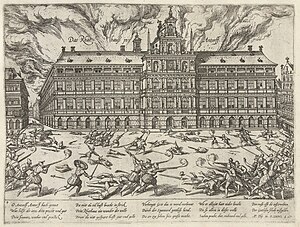
Back Испанска ярост Bulgarian Fúria espanyola Catalan Ισπανική μανία Greek Furia española Spanish Furie Espagnole French Furia Española Galician Furia spagnola Italian Spaanse Furie Dutch Fúria Espanhola Portuguese

The Spanish Fury (or the Spanish Terror) was a number of violent sackings of cities (lootings) in the Low Countries or Benelux, mostly by Spanish Habsburg armies, that happened in the years 1572–1579 during the Dutch Revolt. In some cases, the sack did not follow the taking of a city. In others, the sack was ordered, or at least not restrained, by Spanish commanders after the fall of a city.
The most notorious Spanish Fury was the sack of Antwerp in November 1576. In English, this, and the mutinous campaign of 1576 in general, tends to be what is meant by "Spanish Fury". In Dutch, the term includes a wider range of sackings, in particular the city punishments of 1572.[1][2][3] The events of the Spanish Fury contributed to the creation of anti-Spanish sentiment in many parts of Europe.
- ^ Caffin, Charles H (February 1912). "V. The Scientific-Artistic Organization of Holland in the Seventeenth Century". Art for Life's Sake – An Application of the Principles of Art to the Ideals and Conduct of Individual and Collective Life. The Prang Company, New York–Chicago–Boston–Atlanta–Dallas, USA (ex. University of Toronto Library N7445C25c.1ROBA online by Scribd.com). p. 38. ISBN 978-1-120-15859-8. (paperback pub. by Kessinger Publishing). Archived from the original on 18 July 2011. Retrieved 4 August 2011.
Philip replied by dispatching Alva and ten thousand troops, who inaugurated the 'Spanish Fury,' in which eighteen thousand six hundred persons were put to death, beside those who were killed in armed resistance.
- ^ Krüger: "Die 'Spaanse Furie' wütete über mehrere Jahre: Mecheln, Zutphen und Naarden wurden geplündert, ebenso Haarlem, Oudewater und Bommende. Am Schlimmsten aber traf es Antwerpen"
- ^ Van der Schoot, Y. "De Hervorming te Brugge" (PDF) (in Dutch). Protestantse Kerk Brugge, Brugge, Belgium. Retrieved 31 July 2011.
{{cite web}}: External link in|publisher=